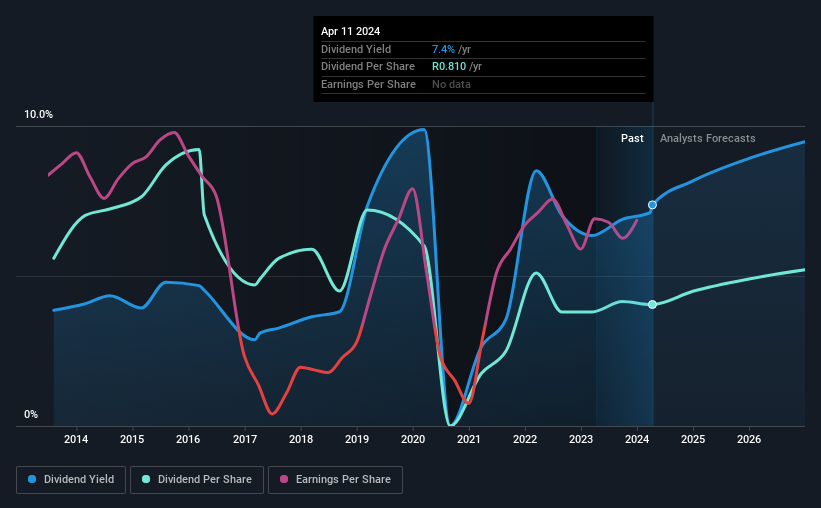Stock Analysis
- South Africa
- /
- Insurance
- /
- JSE:OMU
Old Mutual Limited (JSE:OMU) Passed Our Checks, And It's About To Pay A R00.49 Dividend

It looks like Old Mutual Limited (JSE:OMU) is about to go ex-dividend in the next four days. The ex-dividend date occurs one day before the record date which is the day on which shareholders need to be on the company's books in order to receive a dividend. The ex-dividend date is an important date to be aware of as any purchase of the stock made on or after this date might mean a late settlement that doesn't show on the record date. Therefore, if you purchase Old Mutual's shares on or after the 17th of April, you won't be eligible to receive the dividend, when it is paid on the 22nd of April.
The company's next dividend payment will be R00.49 per share. Last year, in total, the company distributed R0.81 to shareholders. Looking at the last 12 months of distributions, Old Mutual has a trailing yield of approximately 7.4% on its current stock price of R010.99. Dividends are a major contributor to investment returns for long term holders, but only if the dividend continues to be paid. So we need to check whether the dividend payments are covered, and if earnings are growing.
Check out our latest analysis for Old Mutual
Dividends are typically paid out of company income, so if a company pays out more than it earned, its dividend is usually at a higher risk of being cut. Old Mutual is paying out an acceptable 51% of its profit, a common payout level among most companies.
Generally speaking, the lower a company's payout ratios, the more resilient its dividend usually is.
Click here to see the company's payout ratio, plus analyst estimates of its future dividends.

Have Earnings And Dividends Been Growing?
Businesses with strong growth prospects usually make the best dividend payers, because it's easier to grow dividends when earnings per share are improving. If earnings fall far enough, the company could be forced to cut its dividend. That's why it's comforting to see Old Mutual's earnings have been skyrocketing, up 23% per annum for the past five years.
The main way most investors will assess a company's dividend prospects is by checking the historical rate of dividend growth. Old Mutual's dividend payments per share have declined at 3.2% per year on average over the past 10 years, which is uninspiring. It's unusual to see earnings per share increasing at the same time as dividends per share have been in decline. We'd hope it's because the company is reinvesting heavily in its business, but it could also suggest business is lumpy.
Final Takeaway
Should investors buy Old Mutual for the upcoming dividend? Earnings per share are growing nicely, and Old Mutual is paying out a percentage of its earnings that is around the average for dividend-paying stocks. Overall, Old Mutual looks like a promising dividend stock in this analysis, and we think it would be worth investigating further.
On that note, you'll want to research what risks Old Mutual is facing. To that end, you should learn about the 2 warning signs we've spotted with Old Mutual (including 1 which is concerning).
A common investing mistake is buying the first interesting stock you see. Here you can find a full list of high-yield dividend stocks.
Valuation is complex, but we're helping make it simple.
Find out whether Old Mutual is potentially over or undervalued by checking out our comprehensive analysis, which includes fair value estimates, risks and warnings, dividends, insider transactions and financial health.
View the Free AnalysisHave feedback on this article? Concerned about the content? Get in touch with us directly. Alternatively, email editorial-team (at) simplywallst.com.
This article by Simply Wall St is general in nature. We provide commentary based on historical data and analyst forecasts only using an unbiased methodology and our articles are not intended to be financial advice. It does not constitute a recommendation to buy or sell any stock, and does not take account of your objectives, or your financial situation. We aim to bring you long-term focused analysis driven by fundamental data. Note that our analysis may not factor in the latest price-sensitive company announcements or qualitative material. Simply Wall St has no position in any stocks mentioned.
About JSE:OMU
Old Mutual
Old Mutual Limited, together with its subsidiaries, provides financial services primarily in South Africa and rest of Africa.
Proven track record and fair value.

